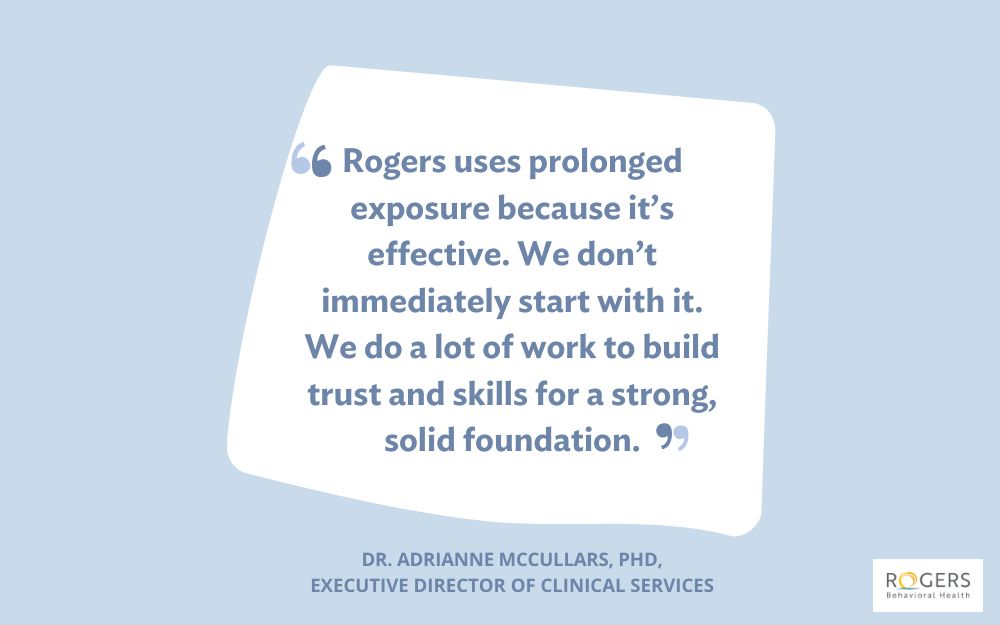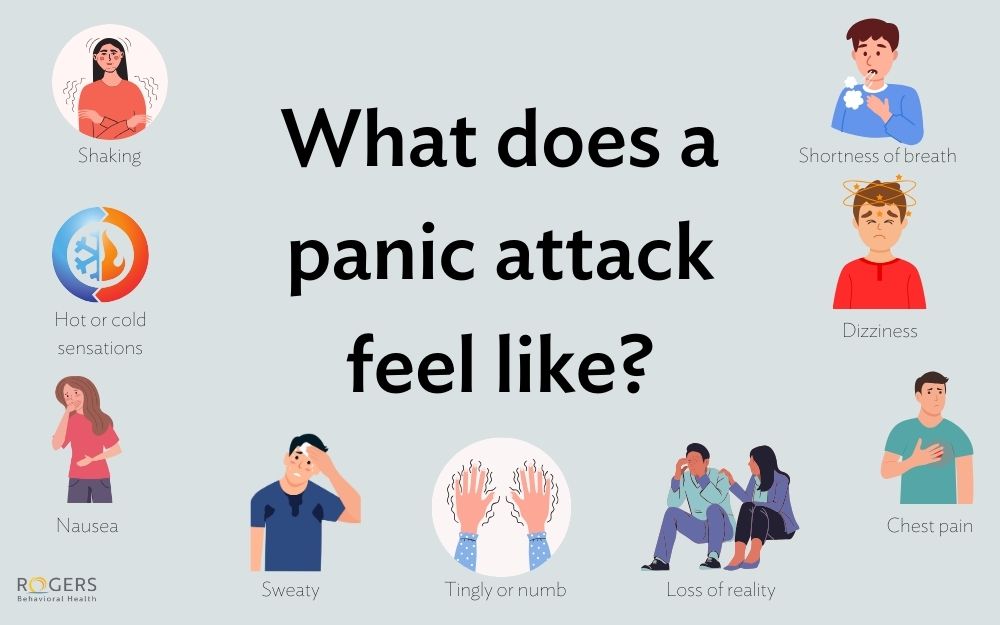Prolonged exposure for trauma therapy
Posted on 06/10/24 12:48:pm
Share this article:
By Adrianne McCullars, PhD, psychologist, executive director of clinical services for Rogers' locations in Pennsylvania, Tennessee, Georgia, Florida, and Washington
Trauma definition
Trauma is our response to witnessing, experiencing, or even hearing about a very stressful, frightening, or distressing event that is difficult to cope with and is out of our control. Most people experience a traumatic event at some point in their lives. For some, types of trauma can be an isolated incident, while for others, it's multiple incidents, or events that occur over a specific period of time.
The impact of trauma
Trauma causes a strong emotional response. Although people respond to traumatic events differently, they tend to feel afraid, helpless, or horrified by what’s happening around them or to them. Additionally, they can experience:
- Anger
- Anxiety
- Numbness
- Grief
- Shame
- Confusion
Trauma also causes physical reactions like:
- Headaches
- Shaking
- Sweating
- Memory problems/difficulty concentrating
- Fatigue or trouble sleeping
The symptoms of trauma are quite common immediately after a traumatic event, but for most, through natural recovery, the intensity and frequency of these symptoms decrease over time.
What is prolonged exposure in Rogers’ trauma therapy programs?
There are four primary components of prolonged exposure (PE) in Rogers' trauma therapy programs:
- Education. We educate our patients on what PE is, how we approach it, and how they will experience it. We provide people with a lot of skills and time to practice them to ensure that they’re ready to engage with trauma-specific work. That includes skills for distress tolerance or emotion regulation, mindfulness, and relaxation.
- Imaginal exposures. As people recall their traumatic stories, we help them work through it. Once they've told their story repeatedly over multiple sessions, their distress reduces over the course of time.
- Real world exposures. We work with our patients to build a trauma hierarchy, which consists of people, places, and objects (by level of intensity) which they may be avoiding because it reminds them of their traumatic experience. Slowly, and as they’re ready, we help them approach or engage with these trauma reminders.
- Breathing retraining. This is a huge part of PE that helps people work through their trauma. Think about when somebody is hyperventilating, or they're getting very worked up, anxious, or frightened in a situation. Their heart rate increases along with their breathing, which can lead to an increase in feeling afraid and anxious. Sometimes, when people think about their trauma, or they’re around things that remind them of it, they may experience these physical symptoms. Breathing retraining teaches them to slow down, breathe in through the nose and slowly out through the mouth at specific counts to calm the physical reactions, which helps them stay in the present moment and realize they’re in a safe space.
PE is based on two factors that reinforce trauma-related difficulties: avoidance and negative beliefs. Avoidance helps to sustain trauma symptoms, which prevents people from fully processing what happened. The second is negative beliefs. A lot of times people who have had traumatic experiences hold negative beliefs that the world is very dangerous or that everyone is untrustworthy. They generalize what happened in their trauma to the rest of the world. Engaging in real world exposures increases a sense of self-control and competence, which helps people feel better about themselves as they stop avoiding memories, thoughts, feelings, and situations and learn to master the fear.
Rogers uses PE because it’s very effective and fits together well with our behavioral focus. For OCD, we use ERP, exposure and response prevention. For depression recovery, we use behavioral activation. We like to target behaviors and use the change in those behaviors to then challenge and change our patients’ thoughts and emotions. Targeting the behavioral piece influences the cognitive piece, or a how person thinks about the trauma, and the emotional part of a person's recovery.
What are common misconceptions about PE?
One of the most common misconceptions I’ve heard is that PE is retraumatizing individuals. Many people with trauma say when they think or talk about their trauma, it feels as if it’s happening again, which explains why they’re anxious and distressed. In fact, retelling the memory has several benefits. It helps to organize the memory and provides new perspective about what happened. It also helps the person strengthen the difference between the present (remembering), and the past (being traumatized), so that remembering the trauma will stop causing anxiety and distress.
Another misconception is that PE is not compassionate. I want people to know we don’t immediately start with PE. We do a lot of work to build trust and skills to create a strong, solid foundation. If someone isn’t ready to start imaginal exposures, we may start with the real world exposures. We really do meet patients where they are and tailor the treatment to each person. We want to ensure our patients are ready and feel confident about doing the PE work before we begin.
Our Trauma Recovery programs give people the space and time to do the work they need to do. Our outcomes show that not only is the quality of life for our patients increasing, but their trauma symptoms are decreasing at discharge. That's what we strive for when people seek our help.
Trauma Recovery at Rogers Behavioral Health
Rogers’ compassionate team of experts is ready to help if you or someone you love is struggling with trauma. We offer:
- PTSD inpatient care to help patients (children and adults) with acute needs for medical stabilization. We offer inpatient care at three hospital locations in southeastern Wisconsin: Brown Deer, Oconomowoc, and West Allis.
- Residential trauma treatment provides adults suffering with the intense effects of trauma and PTSD, residential care in a home-like setting for Trauma Recovery in Oconomowoc.
- Partial Hospitalization Outpatient Care (PHP), for adults and adolescents 6 hours a day, 5 days a week. Intensive, structured treatment that provides more hours of therapy in a week and allows patients to remain connected with their social support network. Patients, families, and treatment teams work together to determine the length of programs based on individual progress and situations.
Learn more about trauma, trauma treatment, and posttraumatic stress disorder by visiting our PTSD and trauma facts page.
To get started, call 800-767-4411 for a free, confident screening.



